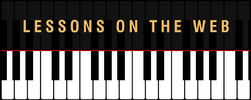|
Have you ever sat down at the piano to start your practicing and a few minutes into playing you realize that your thoughts have been on something totally different than what you were practicing on? Even after several attempts to concentrate on your piano playing, your thoughts just won’t cooperate! When this happens, it is usually a symptom of being too busy, too tired, stressed out, and/or just living in a bit of a chaotic state no matter what the cause is. Our minds are not working with our bodies; they seem to be doing independent things instead of working as a team and we can’t get the things done that we want to. If this is happening at the piano it’s probably also happening in other areas of our lives too. When you notice this happening in your practicing - get your metronome out.
Go back to a scale that you know very well and can play easily. Now turn on your metronome and set it at a very slow tempo. Before you start playing the scale…do this:
You may want to repeat this exercise a couple of times before moving back to what you were originally trying to work on in your practicing. That’s fine! Remember, this is to help bring you fully into your practice time so you can accomplish your goals. Being ‘fully present’ in piano practicing means that our thoughts and body are working or practicing together. We can’t do everything in our heads and we can’t do what we need to with our fingers and hands if our thoughts aren’t telling them what to do. The metronome can serve to bring these two aspects together because it connects with the rhythm part of our brains and our body’s energy system. The regular beat that it gives us provides a framework that we can utilize to shut out anything other than our fingers on the keyboard and the steady drum beat of the metronome. Once you have gotten used to using the metronome with scales you will want to apply this same practice to playing arpeggios, exercises and any pieces that you’ll end up working on. The metronome helps us to play with more clarity, learn the correct notes and rhythms, and enables us to play at a tempo that will accommodate what we are working on without having to stress out about it. Besides helping us get grounded so we can accomplish more in our practicing, there are lots of other benefits to using a metronome no matter what we’re working on. Here are several videos that cover all aspects of what a metronome is and how to start using one in your own practicing. If you have never used a metronome before, this video will introduce you to what one is, how it works, where you can find one and I’ll use one while playing so you can see how it works. This next video takes us through some easy pieces with the metronome and what to do when you make mistakes or can’t get your fingers to play in the correct tempo. This final video includes some original rhythm patterns for us to figure out how to count and play with the metronome at the same time. Watch this one at your keyboard so you can practice along with me…and don’t forget your metronome! If you like my tips and lessons, you will love the courses over on my website. Whether you are a beginner looking to get a solid foundation to build on or you are looking to take you existing skills to that next level, the online music courses on my website - https://www.pianolessonsontheweb.com will help you do just that.
Leave a Reply. |
AuthorMost blogs written by Archives
June 2020
Categories
All
|

 RSS Feed
RSS Feed